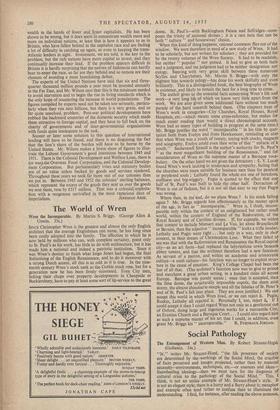The World of Wren
SrNCE Christopher Wren is the greatest and almost the only English architect that the average Englishman can name, he has long since been cosily adopted into the family. The affection in which he is now held by millions who can, with complete certainty, point only to St. Paul's as his work, has little to do with architecture, but it has made him a national and indeed a patriotic institution. Since it was Wren's destiny to finish what Inigo Jones had begun, the final Italianising of the English Renaissance, and to do it moreover with a strong Dutch accent, all this is as odd as it is true. In the nine- teenth century Wren's stock sank as the Gothic stock rose, but for a generation now he has been firmly reinstated. Even City men, licking their chops over property developments in Cheapside or Bucklersbury, have to pay at least some sort of lip-service to the great dome. St. Paul's—with Buckingham Palace and Selfridges—com- poses the trinity of national shrines ; it is a rare item that can be both " culture " and housewives' choice.
When this kind of thing happens, rational comment flies out of the window. We were therefore in need of .a new study of Wren. It had to be scholarly, but not written for scholars ; they are provided for by the twenty volumes of the Wren Society. It had to be readable, but neither popular " nor potted. It had to give us both facts and a judgment, and the judgment had to be neither denigration nor eulogy. Steering with very great skill between these numerous Scyllas and Charybdises, Mr. Martin S. Briggs—with only the slightest bias towards eulogy—has done his work skilfully and even brilliantly. This is a distinguished book, the best biography of Wren in existence, and likely to remain the best for a long time to come. The authdr gives us the essential facts concerning Wren's life and work—,a very long life of which we know very little apart from the work. We are also given some 'additional facts without too much parade of the hard research behind them. (The chapters treat of Wren's work in categories—City Churches, Royal Houses, Royal Hospitals, etc.—which means some cross-reference, but makes for much easier reading than would a direct chronological account. Wren had so many types of building in progress at the same time.) Mr. Briggs justifies the word " incomparable " in his title by quo- tation both from Evelyn and from Hawksmoor, reminding us also that when Wren was a youth of twenty, toying with clocks, magnets and sciagraphy, Evelyn could even then write of that " miracle of a youth." Sacheverell Sitwell is the author's authority for St. Paul's " as the most magnificent building of the Renaissance," and for consideration of Wren as the supreme master of a Baroque voca- bulary. On the other hand we are given the detractors : E. V. Lucas found Wren's work lacking in tenderness and sympathy, feeling that the churches were more suitable for business men than for penitent or perplexed souls ; Lethaby found the whole era one of boredom, stuffiness and big-wiggery. Pugin is quoted to the effect that one half of St. Paul's was built to hide the other half. Detraction of Wren is out .of fashion, but it is not all that easy to say that Pugin was wrong. Where then, in the end, do we place Wren ? Is his stock falling again ? Mr. Briggs regards him affectionately as the master spirit of the age, in fact as " incomparable." Wren is, I think, incom- parable only within the context of an enlightened but rather small world, within the context of England of the Restoration, of the Royal Society and of Caroline divines. If, for example, we widen that context to include Mansart and lee Vau, let alone Brunelleschi or Bernini, then the adjective " incomparable " looks a trifle insular. Lethaby and Pugin were right ... but only in a way, only in their context, in their dream of Christendom Lost. What they failed to see, was that with the Reformation and Renaissance the Royal capital city—as an art form—had replaced the labyrinthine town beneath abbey towers, and that the architect therefore had a new function. As servant of a patron, and within an academic and aristocratic culture—a snob culture—his function was no longer to exploit struc- ture in the cause of emotion. King's College Chapel had been the last of all that. (The architect's function now was to give to prince and merchant a great urban setting, in a hundred cities all across Europe. Baroque was purely scenic ; once that is accepted, then the false dome, the structurally impossible cupola, the sham attic storey, the almost chinoiserie steeple and all the falsities of St. Peter's and of St. Paul's fall into place. They are even justified.) We can accept this world in which Wren lived, or we can reject it. Pugin, Ruskin, Lethaby all rejected it. Personally I, too, reject it, If I could accept it then I could regard Wren not only as a gentleman out of Oxford, doing large and ingenicrus works for a mercantile City, an Erastian Church and a Baroque Court ... I could also regard him as such a supreme master of his art that I could, in addition, even grant Mr. Briggs his " incomparable." R. FURNEAUX JORDAN.


































 Previous page
Previous page